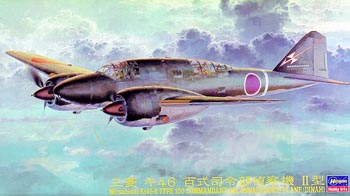 Hasegawa's
1/72 Mitsubishi Ki-46-II
Hasegawa's
1/72 Mitsubishi Ki-46-II
Type 100 "Dinah"
By Chris Bucholtz
History
When it came to high-altitude, high-speed long-range reconnaissance, the Ki-46 was second to none in World War II. Flying at 35,170 feet at a top speed of 375 mph, the Ki-46 operated with impunity over Southeast Asia for the first part of the war until the arrival of the Spitfire Mk. VIII in late 1943 and the introduction of the Mustang and Thunderbolt earlier that year. Even after these fighters arrived, it took a careful bit of piloting to catch and down the Dinah, as it was code-named by the allies, and it continued flying reconnaissance missions over B-29 bases in the Marianas and over advancing Russian troops in Manchuria up to the closing days of the war.
While most IJAAF aircraft were designed with the pre-war expectation that the next opponent would be the Soviet Union, requiring short-range aircraft suited for cold weather, the Ki-46 was designed with a realization of the vastness of the potential battlefields of future wars. A requirement was issued for a plane that could remain aloft for six hours at a speed of 249 mph was issued, and Mitsubishi designer Tomio Kubo was able to draw on his company's work on twin-engine types to produce a design with a narrow fuselage and thin wing section. This aerodynamically revolutionary aircraft was the subject of extensive wind-tunnel tests, and getting it just right took time. The first plane was not finished until November 1939, two years after the requirement was issued.
Despite engine difficulties, the Ki-46-I was still faster than the yet-to-be-delivered Ki-43 fighter and the A6M2 Zero, and the Army was enthusiastic about the aircraft. Further mechanical teething problems dogged the plane into 1941, including frequent vapor locks, overheating and landing gear collapses. Most of the difficulties were overcome, and the Ki-46 took an active role as tensions boiled over in the Pacific.
In July 1941, the Ki-46 began operations in China, easily eluding the outdated Chinese fighters tasked with intercepting it. On Oct. 20 and 22, 1941, a Ki-46-II overflew Malaya and Singapore, mapping the territory in advance of Japanese thrusts into these areas. Again, British fighters were impotent to stop these flights. The performance of the Ki-46-II was so impressive that the Imperial Japanese Navy, whose war with the Army was nearly as bitter as its war with the Allies, negotiated the acquisition of a few aircraft. Navy Ki-46s flew regular missions over Northern Australia from bases in Timor, and the Army flew as far west as the Bay of Bengal.
The arrival of the Spitfire V and the P-38F caused some losses and hastened the introduction of the Ki-46-III, with the smoothly-faired forward fuselage and upgraded engines. The Ki-46-III regained some of the type's superiority, but the sheer numbers of advanced allied fighters now opposing it robbed Japanese pilots of their earlier sense of invulnerability. An earthquake that severely damaged the Nagoya plant where the planes were made, and in desperation the Ki-46 was converted into a nightfighter and interceptor.
Despite its late-war losses, the "Dinah" was still among the finest reconnaissance aircraft of the war when hostilities ceased. As if to punctuate its career, two Ki-46-IVs made a flight in February 1945 that spanned 1,430 miles at an average speed of 435 mph--a remarkable feat for any plane of that era. It is telling that the Luftwaffe tried repeatedly to gain a manufacturing license to build the Ki-46 for its own use.
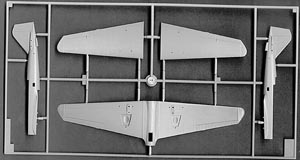 The
Kit
The
Kit
Hasegawa has been on a run of releasing all the Japanese twin-engine combat types, including the Ki-45 "Nick," the P1Y "Frances," the G3M "Nell" and the Ki-67 "Peggy." The Ki-46 is the most attractive of the lot, and this kit my be the nicest of the recent run of kits from Hasegawa. The parts breakdown indicates a Ki-46-III is on the way, too.
The interior has more than your typical Hasegawa kit, but there's still room for improvement. The cockpit contains a seat with a rear bulkhead, a control wheel and an instrument panel (details provided on a decal). The observer's position has a seat, a radio and a rear bulkhead. There's some stringer and former detail on the fuselage sides, but it's peppered with ejection pin marks.
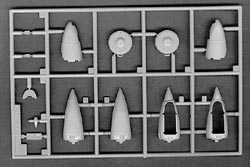 This
cockpit fits inside the fuselage halves; because of the extensive glazing,
these look very odd at first. The nose is a separate section that mates
neatly to the fuselage at the wing join line. A faint sink mark mars the
nose pieces, but this can be corrected with a bit of filler and sanding.
The wing itself is a nice bit of construction, with the nacelles provided
as halves that go on the top and bottoms of the wings. A small bit of
wheel well detail is included on the bottom of the wings. The panel line
detail is recessed and is very crisp.
This
cockpit fits inside the fuselage halves; because of the extensive glazing,
these look very odd at first. The nose is a separate section that mates
neatly to the fuselage at the wing join line. A faint sink mark mars the
nose pieces, but this can be corrected with a bit of filler and sanding.
The wing itself is a nice bit of construction, with the nacelles provided
as halves that go on the top and bottoms of the wings. A small bit of
wheel well detail is included on the bottom of the wings. The panel line
detail is recessed and is very crisp.
The engine assembly recalls Hasegawa's recent Beaufighter: a row of cowl flaps goes on first, followed by a fairly nice engine and crank case. Over this go the close-fitting cowlings. The propellers have some flash and need to be cleaned up; once this is accomplished, they slide into polyvinyl caps in the engine crankcase and are topped with long bullet-shaped spinners.
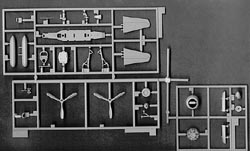 The
landing gear have single-piece struts with separate retraction struts.
A single ejection pin mars each strut, and while not impossible to fix,
they are in a tricky spot that will require care. The wheels also have
two ejection pin marks, but these are entirely on the tire section, making
them salvageable (as opposed to those wheels that have pin marks straddling
the tire/wheel juncture). The landing gear doors also have pin marks on
their inner surfaces, but at least there's no detail in this area that
would be ruined by fixing them.
The
landing gear have single-piece struts with separate retraction struts.
A single ejection pin mars each strut, and while not impossible to fix,
they are in a tricky spot that will require care. The wheels also have
two ejection pin marks, but these are entirely on the tire section, making
them salvageable (as opposed to those wheels that have pin marks straddling
the tire/wheel juncture). The landing gear doors also have pin marks on
their inner surfaces, but at least there's no detail in this area that
would be ruined by fixing them.
Once the gear's on the plane, it's time for the transparencies, and there are lots of them. The windscreen, center section and observer's section are separate pieces, which will necessitate some careful sanding and blending. other small windows go into the nose, belly and sides of the model; these might be best left off until after painting. An antenna mast and DF "football" are included as options; my football had a big sink mark at its base.
Decals allow you to build five machines. The most colorful overall are
the IJA Green 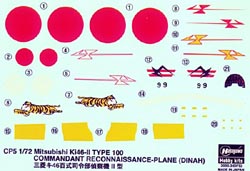 over
gray planes from the 81st Sentai. The kit gives you tail markings for
the First, Second and Third Chutais; the first Chutai includes a line
of stars representing successful sorties. The two other planes represented
are overall IJN gray-green; one belongs to the 2nd Sentai, and the other
to the 18th Chutai Independent Flight. The last machine has a cartoon
tiger on its tail. As is usually the case for Hasegawa, the decals are
a little thick but are printed beautifully.
over
gray planes from the 81st Sentai. The kit gives you tail markings for
the First, Second and Third Chutais; the first Chutai includes a line
of stars representing successful sorties. The two other planes represented
are overall IJN gray-green; one belongs to the 2nd Sentai, and the other
to the 18th Chutai Independent Flight. The last machine has a cartoon
tiger on its tail. As is usually the case for Hasegawa, the decals are
a little thick but are printed beautifully.
Conclusion
Despite the minor niggles identified in this review, this really is a splendid little kit. Hasegawa has been good to us multi-engine prop fans over the last few years, and this model is further evidence that the trend has not come to an end. Well done, Hasegawa!




